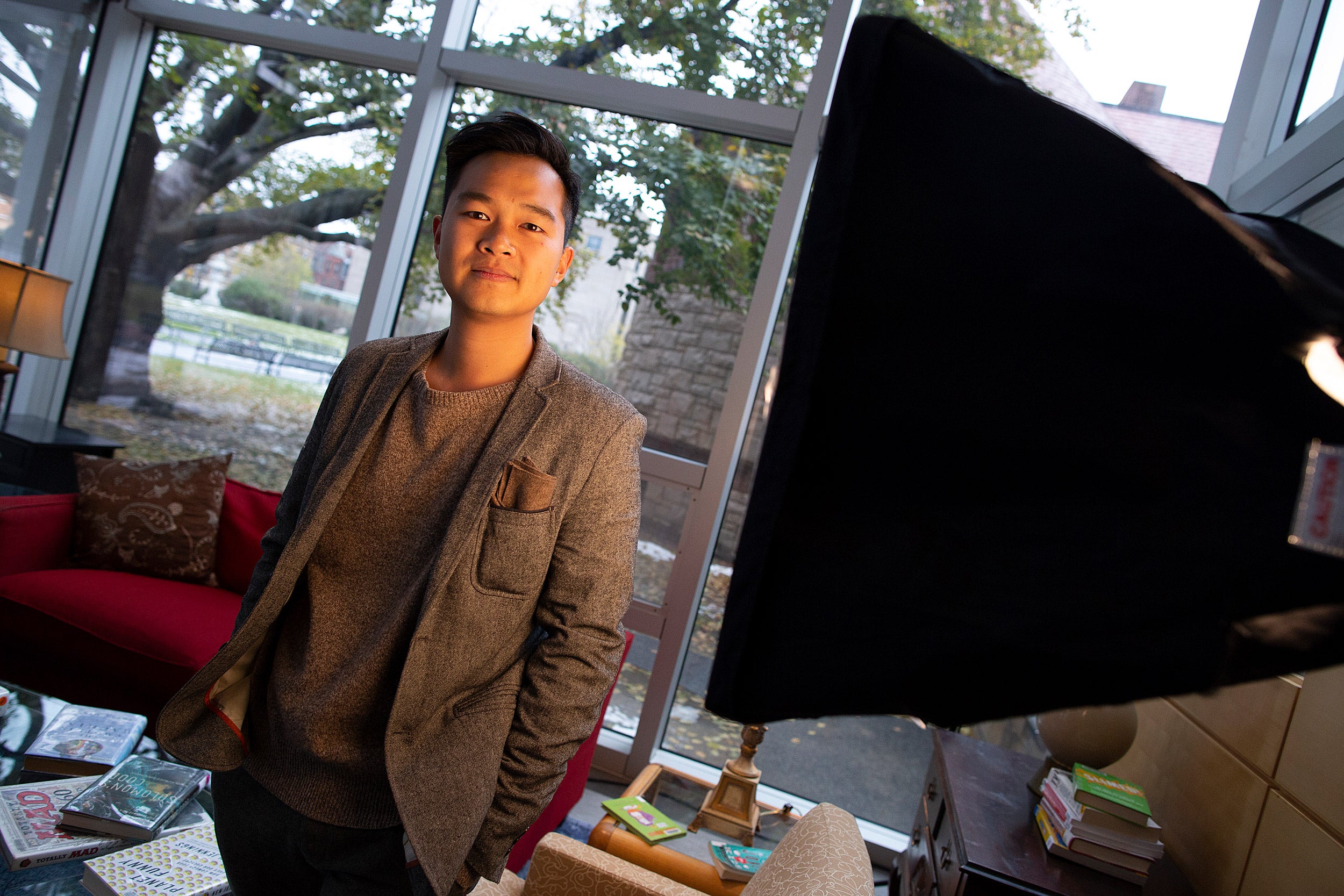
Stephanie Frampton (from left), Chris Sun, Sarah Newman, and Nikhil Dharmaraj gather in “The Laughing Room,” an installation at Cambridge Public Library evoking a sitcom set with an algorithm-controlled laugh track.
Photos by Stephanie Mitchell/Harvard Staff Photographer
Funny, creepy, or both?
‘Laughing Room,’ metaLab researcher’s installation, turns a visit to the library into a sitcom-like experience — only deeper
The space appeared bright and cozy: the perfect family living room, with a sofa, easy chairs, and a coffee table that held, among other things, an anthology of Mad magazines. Only the illumination didn’t come from the table lamps, and three of the walls were glass. A visitor’s remarks on the brightness of the camera lights set off disembodied chuckles. That response was what defined “The Laughing Room,” a weekend installation at the Cambridge Public Library.
The brainchild of Jonny Sun, a doctoral candidate at MIT and a researcher at Harvard’s metaLab, “The Laughing Room” was created with help from MIT Associate Professor of Literature Stephanie Frampton’s ARTificial Intelligence group. It was a two-campus immersive experience, designed to enlighten as well as entertain. The room in the Cambridge library, wired for artificial intelligence, functioned almost like the set of a sitcom, turning visitors into self-conscious performers as their comments triggered an algorithm-controlled laugh track. This, in turn, influenced visitors’ behavior.
Meanwhile, MIT’s Hayden Library was the setting for “The Control Room,” the second part of the installation, where large screens carried live streams from the Cambridge Public Library.
The overall effect was unnerving, making the Laughing Room’s occupants acutely aware of how we alter our behavior depending on the response it provokes.
“This idea of an audience is something I’ve been thinking about a lot,” said Sun, who is also an actor, author, and illustrator. “What it means to perform or to create a version of yourself online to an imagined audience.
“We all perform, to some extent, presenting different facets of ourselves depending on whom we are with,” he added. “Our identity is always based on context and who we’re around. Our sense of self is pretty fluid.”

“This idea of an audience is something I’ve been thinking about a lot. What it means to perform or to create a version of yourself online to an imagined audience.”
Jonny Sun, pictured above
More like this
What is different in today’s world, he said, is the role of social media. Although we may believe we are engaging with our friends on Facebook, Twitter, or Instagram, for example, we are actually interacting with these companies’ algorithms.
“There’s a lot of subtle manipulation,” Sun said. “These are private companies and their goal is to keep people online and to be able to control the engagement,” primarily for the benefit of advertisers.
What we experience as high priority in a social-media feed is actually curation by an algorithm, noted Sun, “designed to control what you see and who you’re being exposed to. And the way a lot of that works is through looking at emotion and the way you engage with certain posts. The laugh track in ‘The Laughing Room’ is this real-world metaphor for a lot of that.”
For programmer and musician Hannah Davis, the project was “an amazing opportunity and conceptually interesting.” She designed the algorithm, which is trained on a large data set of audio transcripts of stand-up comedians.
“This gets people thinking about the kinds of technology we’re increasingly interacting with,” said Matthew Battles, associate director of metaLab. “And it does it with humor.”
“I’m hoping some people will find it funny,” said Sun. He acknowledged that visitors are likely to judge it as “either delightful or Big Brother-y and dystopian and creepy.”
Either response is valid, he stressed. “I’m hoping this creates a microcosm of the conversation that we’re all having.”





